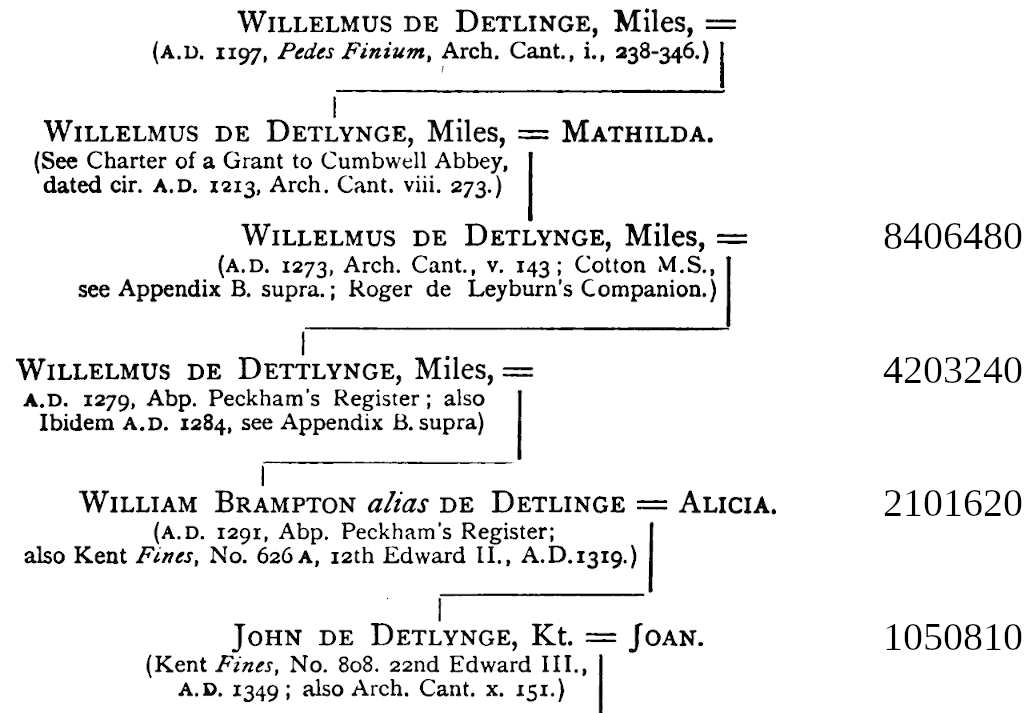- map
- how you can help
- FAQ's
- contact
- copyright
-
ahnentafel and citation # display:| |

| Snapshot: | knight in 13th-century Kent, England murderer |
| Parents: | uncertain |
| Born: | unknown |
| Died: | probably by 28 April 1290/1 location unknown |
| Buried: | unknown |

Who are Below is an excerpt from the pedigree that appears in: I. Cave-Browne, Detling in Days Gone By, or The History of the Parish (Maidstone and London, 1880), page 63. For convenient reference, in the right margin I've added the ahnentafel numbers of my ancestors for whom I've written profiles on this website.  I have considerable confidence in the lower portion of the pedigree. It is supported by sound and mostly clear evidence, as I've detailed elsewhere on this website. The upper portion, however, seems more questionable to me, specifically the top two entries. For those entries, Cave-Browne cites two sources:
If you browse those records, you'll see several mentions of men named William de Detling. I have little doubt that these men are related to In short, although the records that Cave-Browne cites near the top of his pedigree are very interesting (hence why I've provided links to them), I don't feel they provide sufficient evidence to prove (in any meaningful or confident way) the pedigree as written. |
"On his return to England, Sir Roger gathered round him the old associates of his party, and betook himself to raids and forays in Kent, in Wales, indeed, in every part of England. The circumstances of the times — every feudal lord in arms — were peculiarly favourable to the full enjoyment of this his favourite pastime; wherever there was a private wrong to avenge, or aid to be given to his party, there was he foremost in the field. And the state of Kent at this particular period offered more than ordinary facilities for these practices. The King, on leaving England towards the end of A.D. 1262, had provided against his active hostility, by issuing mandates, peremptorily forbidding either Sir Roger himself, or his party, to attend any tournaments, or to be in any way, on any pretext whatever, under arms during his absence from England, without his own special license, on pain of forfeiting their estates. Yet the Chronicle tells us, and actual records confirm the account, that they spent the early part of 1263 in constant forays. Among others, the mesne Lord of the manor of Detling, Sir William de Detlinge, having committed a homicide, the Archbishop of Canterbury, being chief lord, had, in due course, seized the manor into his own hands. Sir William forthwith applies to his neighbour Sir Roger de Leiburn for aid, the two together gather their retainers, and forcibly ejecting the Archbishop's officers, invest Sir Roger's son in the manor, and, as the Chronicler asserts, the Sheriff could no longer attempt to hold his county without a special force of armed men."
1
A record dated 28 April 1290/1 in Otford, Kent reads:
iiij
to Kal. Maij. Apud Otteford in Curia, Willelmus de Dettlinge fecit homagium et fidelitatem Domino pro dimidio feodo militari; quam terram Dominus Willelmus de Dettlinge pater ejus aliquando tenuit.3 English translation: "The 4th day before the Kalends of May. In court at Otford, William of Dettlinge made homage and fidelity to the Lord for half a knight's fee; which land Sir William of Detling his father once held."
As previously explained elsewhere on this site, the latter Dominus Willelmus de Dettlinge pater ejus seems to refer to
(Note: There's also a land record dated 15 August 1279 that mentions Dominus Willelmus Dettelinge, Miles.
| Other records refer to "William de Detling," but because |
1: Reverend L. B. Larking, "On the Heart-Shrine in Leybourne Church," Archaeologia Cantiana, Volume V (1863), page 143. Larking references a somewhat obscure, anonymous, but contemporary manuscript whose origin he further describes on page 166.
2: Lincolnshire Archives reference RA/1/KIRKSTEAD/2/30. I haven't seen the original record and merely used the abstract at the link provided.
3: Charles Trice Martin, ed., Registrum Epistolarum Fratris Johannis Peckham, Archiepiscopi Cantuariensis, Volume III (London, 1885), page 998, an entry that reads, "1291. 4 kal. Maii, at Otford, Wm. de Dettling for the land of Wm. his father." 4 Kal. May corresponds to 28 April 1290/1. A more thorough transcription comes from: I. Cave-Browne, Detling in Days Gone By, or The History of the Parish (Maidstone and London, 1880), page 62. It reads, "iiij
4: ibid., an entry that reads, "17 kal. Sept. at Mortlake, Sir Wm. Detteling for one knight's fee in Detteling." 17 Kal. Sept. corresponds to 15 August using the ancient Roman calendar method. A more thorough transcription comes from: I. Cave-Browne, Detling in Days Gone By, or The History of the Parish (Maidstone and London, 1880), page 62. It reads, "xvij. Kal. Septembr. Dominus Willelmus Dettelinge, Miles, apud Mortelak' in introitu aule, fecit homagium et juravit fidelitatem Domino Archiepiscopo pro uno feodo militari, quod clamat tenere de eo et nullo alio in villa Dettelinge, reddendo annuatim xiij. libras ad quatuor terminos principales."